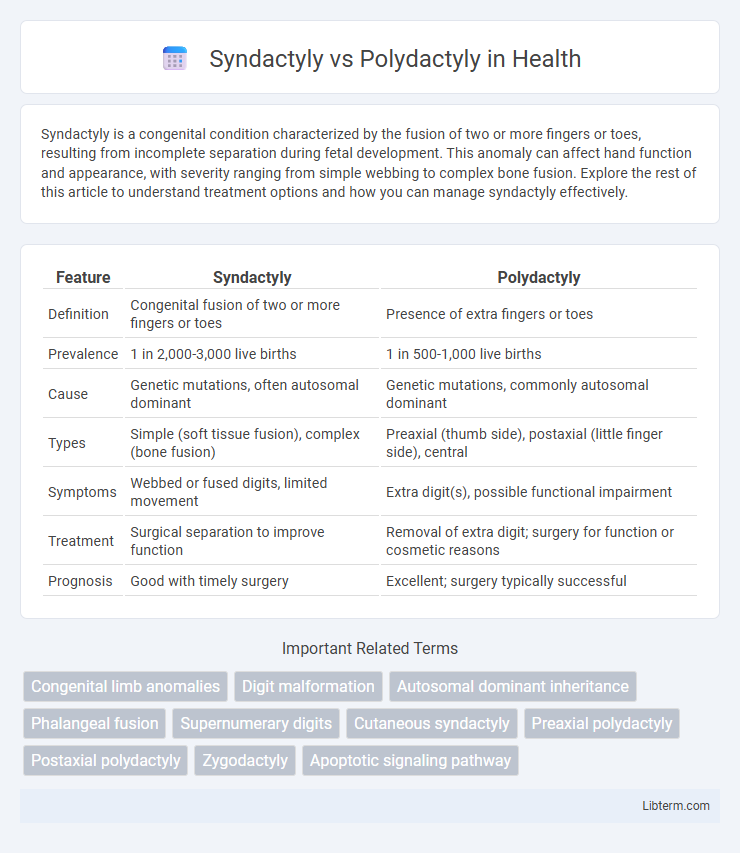Syndactyly is a congenital condition characterized by the fusion of two or more fingers or toes, resulting from incomplete separation during fetal development. This anomaly can affect hand function and appearance, with severity ranging from simple webbing to complex bone fusion. Explore the rest of this article to understand treatment options and how you can manage syndactyly effectively.
Table of Comparison
| Feature | Syndactyly | Polydactyly |
|---|---|---|
| Definition | Congenital fusion of two or more fingers or toes | Presence of extra fingers or toes |
| Prevalence | 1 in 2,000-3,000 live births | 1 in 500-1,000 live births |
| Cause | Genetic mutations, often autosomal dominant | Genetic mutations, commonly autosomal dominant |
| Types | Simple (soft tissue fusion), complex (bone fusion) | Preaxial (thumb side), postaxial (little finger side), central |
| Symptoms | Webbed or fused digits, limited movement | Extra digit(s), possible functional impairment |
| Treatment | Surgical separation to improve function | Removal of extra digit; surgery for function or cosmetic reasons |
| Prognosis | Good with timely surgery | Excellent; surgery typically successful |
Introduction to Syndactyly and Polydactyly
Syndactyly is a congenital condition characterized by the fusion of two or more fingers or toes, resulting from incomplete separation during fetal development. Polydactyly involves the presence of extra fingers or toes, typically caused by genetic mutations affecting limb patterning. Both conditions are among the most common congenital hand anomalies, with variable expressivity and implications for function and aesthetics.
Definition and Key Differences
Syndactyly is a congenital condition characterized by the fusion or webbing of two or more fingers or toes, resulting in partially or completely joined digits. Polydactyly, in contrast, involves the presence of extra fingers or toes beyond the normal number, typically manifesting as an additional digit on the hand or foot. The key difference lies in syndactyly causing digit fusion, whereas polydactyly is defined by digit duplication.
Genetic Causes and Risk Factors
Syndactyly and polydactyly are congenital hand malformations caused by genetic mutations affecting limb development. Syndactyly often results from mutations in the HOXD13 gene, disrupting normal digit separation, while polydactyly is frequently linked to alterations in the GLI3 gene, which impacts digit number formation. Risk factors for both conditions include familial inheritance patterns, with autosomal dominant traits most common, and environmental influences such as maternal smoking or exposure to teratogens during pregnancy.
Types and Classifications
Syndactyly is classified into simple, involving only soft tissues, and complex, which includes bony fusion between digits; it is further divided by the extent of fusion into complete or incomplete types. Polydactyly is categorized based on the location of extra digits: preaxial (thumb or big toe side), postaxial (little finger or toe side), and central, which is less common and involves extra digits between usual fingers or toes. Both conditions are often described using genetic and phenotypic classifications to guide diagnosis and treatment.
Clinical Presentation and Symptoms
Syndactyly presents as the fusion of two or more fingers or toes, often involving soft tissue or bony fusion, leading to webbed or conjoined digits that impair hand or foot function. Polydactyly is characterized by the presence of extra digits, which can range from small, non-functional nubs to fully formed, functional fingers or toes, commonly causing difficulty in grip or shoe fitting. Both conditions may exhibit varying severity and can occur as isolated anomalies or part of genetic syndromes, necessitating clinical evaluation for appropriate diagnosis and management.
Diagnostic Methods
Diagnostic methods for syndactyly primarily include physical examination and radiographic imaging, such as X-rays, to assess the extent of soft tissue or bone fusion between digits. Polydactyly diagnosis relies on clinical evaluation combined with ultrasound or X-ray imaging to determine the number and structure of extra digits and any associated skeletal abnormalities. Genetic testing may be utilized in both conditions to identify underlying mutations or syndromic associations influencing treatment planning.
Treatment Options and Approaches
Treatment options for syndactyly primarily involve surgical separation of fused fingers to improve hand function and appearance, typically performed in early childhood to prevent abnormal bone growth. Polydactyly treatments vary depending on the type and location of the extra digit, ranging from simple excision under local anesthesia to complex reconstructive surgery for fully developed extra fingers or toes. Both conditions require careful preoperative planning and sometimes postoperative physical therapy to ensure optimal functional outcomes and aesthetic results.
Prognosis and Long-Term Outcomes
Syndactyly typically has a favorable prognosis with surgical correction improving finger function and appearance, though outcomes depend on the complexity of the fusion. Polydactyly prognosis is generally positive, with surgical removal of extra digits resulting in normal hand function and minimal complications. Long-term outcomes for both conditions are excellent when treated early, enabling near-normal hand dexterity and minimal impact on daily activities.
Psychological and Social Impact
Syndactyly and polydactyly can significantly affect psychological well-being, often causing anxiety, low self-esteem, and social withdrawal due to visible differences in hand or foot appearance. Children and adults with these conditions may face social stigma, bullying, or exclusion, impacting their social interactions and emotional health. Early surgical intervention and psychological support are critical to improving self-image and promoting social integration.
Advances in Research and Future Directions
Recent advances in genetic research have identified key mutations in the HOXD13 and GLI3 genes, which play significant roles in syndactyly and polydactyly, respectively. Cutting-edge techniques like CRISPR gene editing and 3D limb modeling are driving personalized treatment strategies and improved surgical outcomes. Future research aims to integrate regenerative medicine and stem cell therapy to enable non-invasive correction and enhanced functional recovery for patients with these congenital limb anomalies.
Syndactyly Infographic

 libterm.com
libterm.com